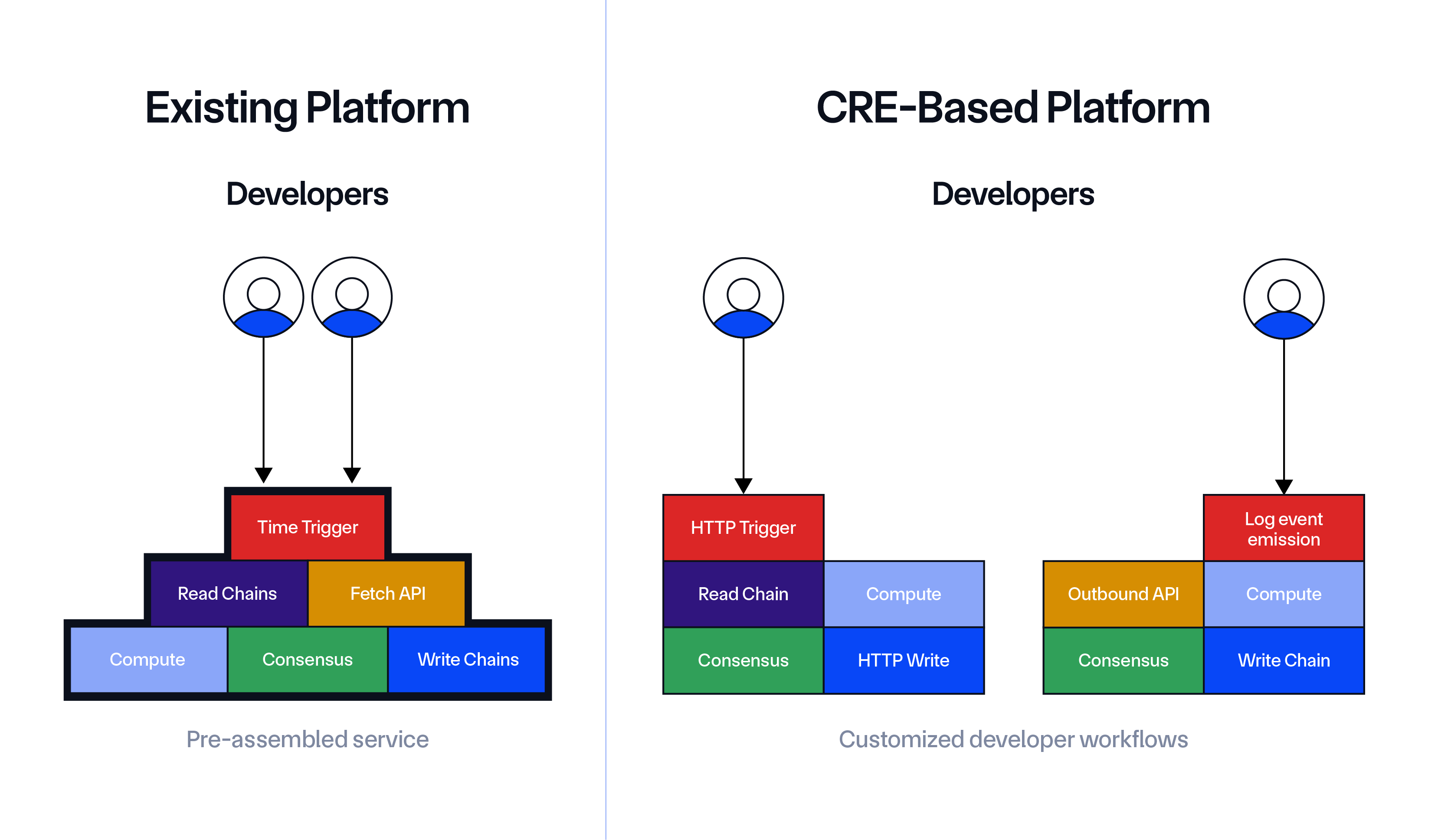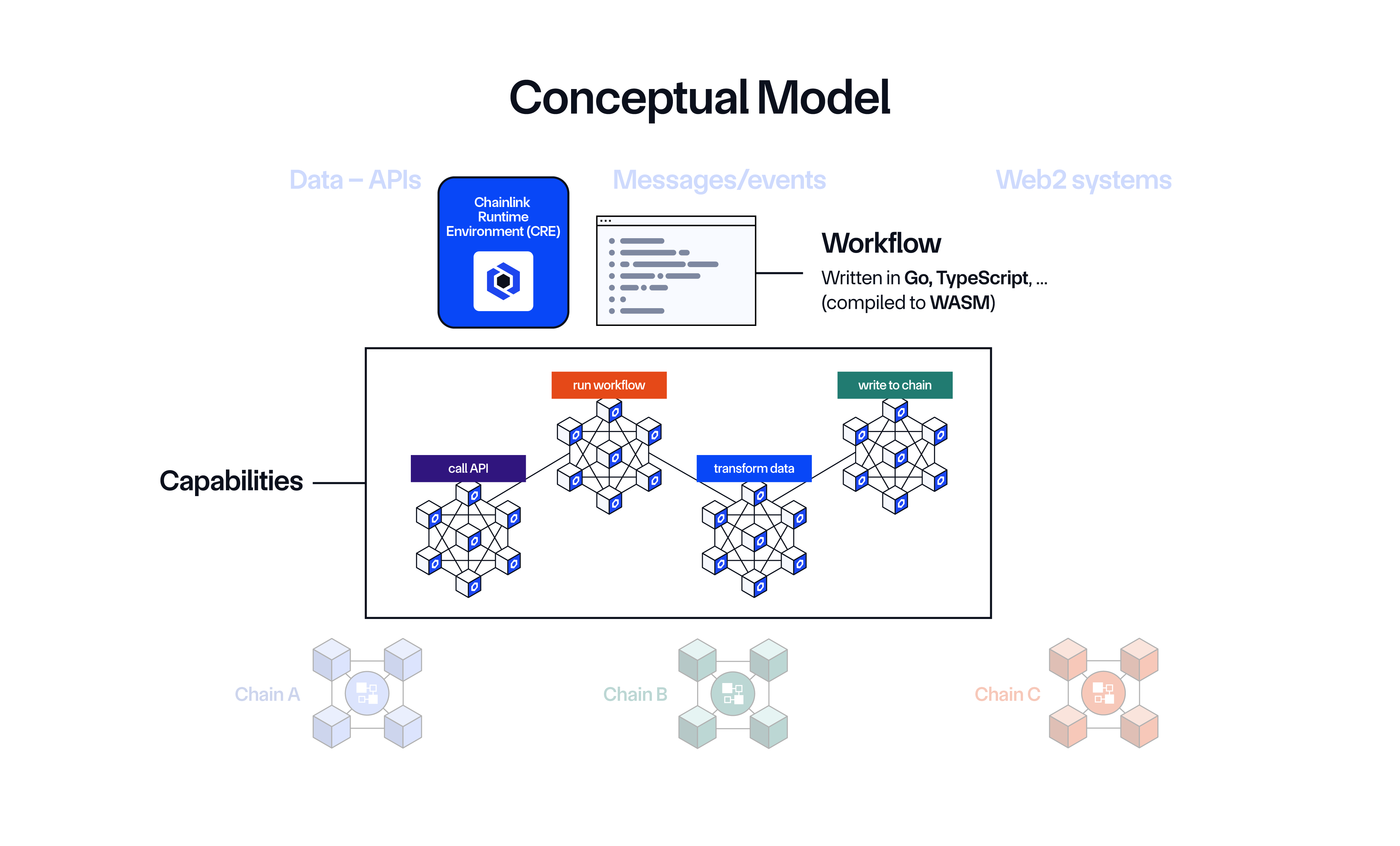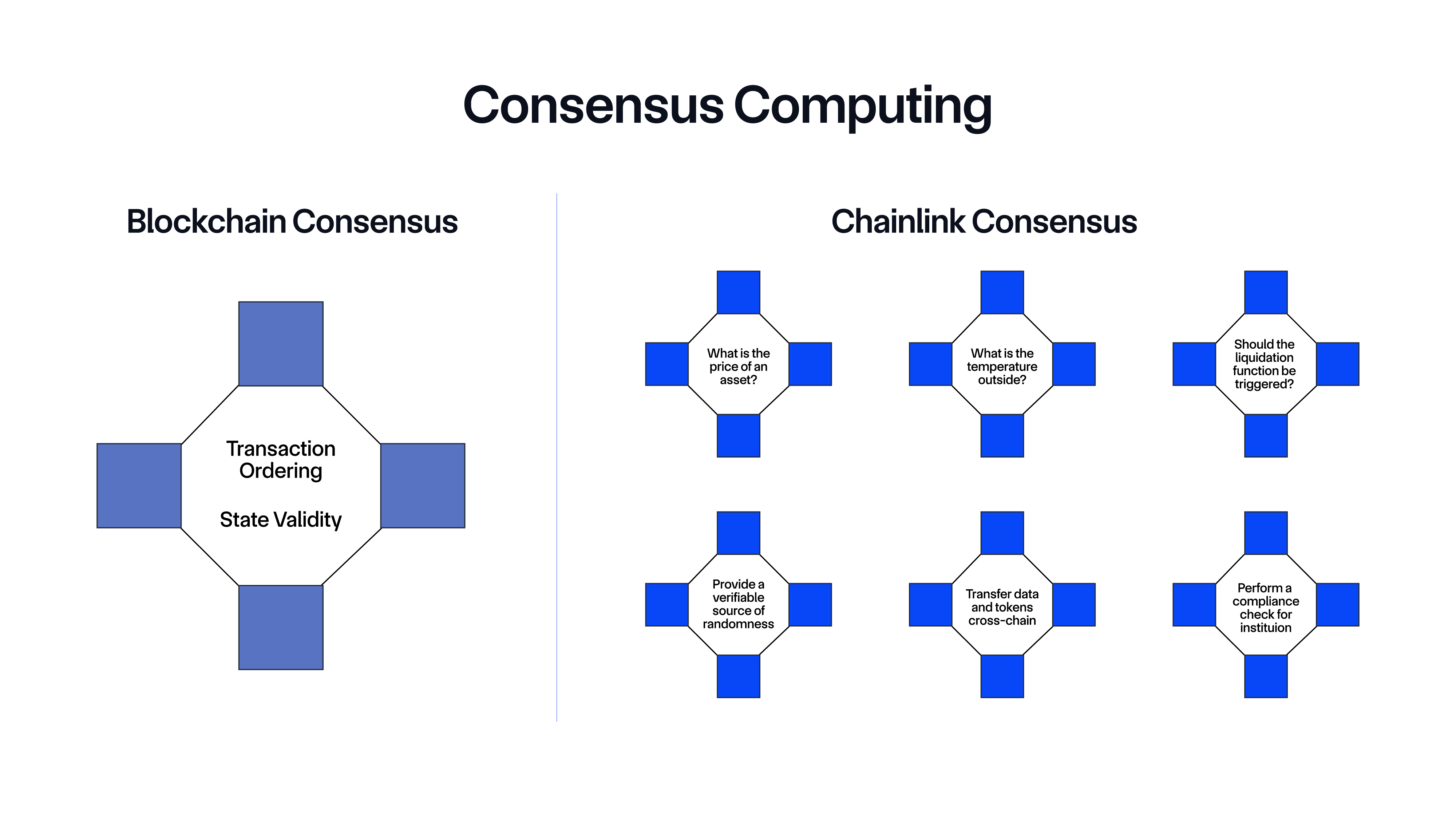Key Takeaways:
The Chainlink Platform is evolving to give developers substantially more power, freedom, and reach than ever before through a highly self-serve, scalable, and programmable architecture.
The core functions of oracle networks are becoming reusable modular capabilities that developers can compose in any way into workflows and run via the new Chainlink Runtime Environment (CRE).
Developers will be able to seamlessly combine all Chainlink capabilities to create customized apps and unlock use cases not bound by any chain, offchain resource, or product integration.
The upgrade of the Chainlink Platform is key to expanding Chainlink to thousands of blockchains and meeting the growing demand from capital markets and Web3.
On the Main Stage at SmartCon 2024 today, we announced a major upgrade to the Chainlink Platform. This upgrade is designed to scale Chainlink across thousands of blockchains, meet the growing demand from financial institutions, and empower developers to build with Chainlink faster, more easily, and with more reach and flexibility than ever before.
Underpinning this initiative is a deep re-architecture of the Chainlink Platform. Drawing inspiration from microservices architecture, the Chainlink node software that manages decentralized oracle networks (DONs) is being broken down into distinct, modular capabilities (e.g., read chain, perform consensus, etc.) that are each secured by independent DONs. Developers can seamlessly combine these capabilities in any number of ways into executable workflows that run via the newly developed Chainlink Runtime Environment (CRE)—the system of DON-based capabilities, DON-to-DON communications, capability orchestration, and code execution on which workflows run with the appropriate consensus model.
The result of this upgrade is developers being able to build substantially quicker, connect their apps seamlessly across all chains connected to the Chainlink Platform, and create more powerful applications, including purpose-built financial apps that interact with capital markets infrastructure, incorporate custom compliance policies, and handle sensitive information in a privacy-preserving manner.
While developers will continue to write core application logic as onchain smart contracts, CRE enables them to deploy code directly on the Chainlink Platform for building and composing capabilities, removing the need to add Chainlink-specific code to their onchain contracts. This allows developers to leverage Chainlink’s capabilities regardless of which blockchains their application is deployed to, leading to unified applications secured end-to-end by consensus computing.
The Evolution Toward a Modular Developer Platform
Existing Platform
To date, the Chainlink Platform consists of a series of prepackaged services, with each service akin to a set of pre-assembled lego pieces that form a single design pattern (i.e., workflow). For example, Chainlink Automation combines 5-6 separate capabilities into a smart contract automation workflow. Each capability has its own parameters, and capabilities must be executed in order to produce a valid workflow output.
Chainlink Automation = Cron/log trigger → read chain → (optional) fetch from Data Streams aggregation network → simulate → consensus → write chain
This service-oriented architecture helped scale Chainlink from 0 to 1, and in the process enabled Chainlink to become the most widely used oracle platform, with the most secure and reliable services across data, smart contract automation, verifiable randomness, cross-chain interoperability, and more.
However, to hyperscale Chainlink to thousands of chains, support millions of new developers at faster development speeds, and unlock a wider range of use cases and customizations across DeFi and fast-emerging TradFi adoption, an upgrade to the architecture of the Chainlink Platform is necessary. And since Chainlink is currently enabling trillions of dollars in transaction value, this transition must take place without any disruption to the security and reliability of existing Chainlink services.
CRE-Based Platform
Chainlink has embarked on a multi-phased initiative to re-architect the Chainlink Platform so developers can build their own custom workflows in a self-serve manner. Essential to this vision is distilling the bare essential functions of an oracle network (e.g., chain read, chain write, fetch API, do compute, etc.) into modular capabilities that developers can directly piece together into their own workflows.
Each capability in a workflow is run by a separate DON (i.e., akin to a microservice) as opposed to the previous architecture where the same DON executes all the capabilities of a particular workflow. For example, instead of having a single DON responsible for executing all 5-6 capabilities of Chainlink Automation, there is one DON per capability and all capability DONs are combined to form a workflow.
With DONs purpose-built to perform one capability, they are able to provide highly reliable and predictable services and quickly scale their support to many different users. Furthermore, the platform itself becomes more efficient as already developed capabilities can be reused as opposed to building the same ones from scratch.

Chainlink Workflows
Workflows are the new programs that developers build and run on the Chainlink Platform. Instead of integrating a prepackaged service, developers can build their own workflows using different Chainlink capabilities. Capabilities can be bucketed into two categories: 1) trigger capabilities that start the workflow and 2) execution capabilities that compose and constitute the workflow.
We plan to support workflow development in Go, TypeScript, and other programming languages, which the platform compiles into WASM for execution by Chainlink nodes. Developers can create and manage their workflows using their IDE and the Chainlink SDK and CLI, as well as view and manage them in a UI.
During the initial launch phases, pre-built capabilities will be provided to devs that they can use to create their custom workflows. The longer-term plan is to enable anyone to create and deploy their own capabilities (e.g., custom self-serve chain integrations, connectivity to permissioned systems, etc.).

Chainlink Runtime Environment
The Chainlink Runtime Environment (CRE)—the engine of the Chainlink Platform—executes developers’ workflows in a decentralized manner by interacting with different capability DONs. CRE provides the coordination of the DONs for each of the capabilities invoked in a workflow, as well as combines them with the right consensus overlay.
“The Chainlink Runtime Environment pulls all of the capabilities together by executing the workflows whenever their triggers fire and using DON-to-DON communications to connect the various capability DONs.” —Uri Sarid, Chainlink Labs Chief Architect
*For a deeper understanding of the different technical terms, refer to the References section at the end of this blog.
The Benefits of the Upgraded Chainlink Platform
The upgraded Chainlink Platform powered by CRE unlocks numerous benefits for developers, the Chainlink Platform itself, and the industry as a whole.
Limitless Developer Innovation
Easy to use: Effortlessly create workflows with programming languages you already know via a comprehensive set of SDKs and an intuitive CLI.
Customizable and programmable: Build to fit your bespoke needs with fully programmable workflows.
Seamless integration: Connect with offchain APIs and multiple blockchains within a single workflow using standardized components.
Secure: Safeguard your users by leveraging Chainlink’s proven security, providing consensus guarantees for offchain applications.
In the previous architecture, for example, standing up a single Proof of Reserve (POR) feed required carefully coordinated operational processes across multiple teams and components. This involved complex customization, deployment, and ongoing maintenance. Chainlink’s new architecture removes the complexity of customizing, setting up, and linking disparate components and reduces the required ongoing maintenance. In a few hours, a single developer can express a fully customized POR feed that writes to multiple chains as a workflow and leverages CRE to monitor and reliably execute it. This frees up precious development and maintenance time, so teams can focus more on meeting customer needs.
Next-Generation Platform
Hyper-scaling: Since capabilities can be long-standing and easily reused for new integrations, new chains can be adopted by simply creating a new read chain / write chain capability, which can then be leveraged by all other Chainlink capabilities to interact with those chains. Instead of a new EVM chain integration for multiple Chainlink products taking weeks, developers can compose workflows that use all Chainlink capabilities within a number of days.
Financial market workflows: Banks can connect the Chainlink Platform to their internal private chains and systems and seamlessly interface across other private and public chains. Financial institutions can also create workflows that work in compliance prior to onchain execution, such as building custom policy capabilities into their workflows.
Limitless use cases: Developers’ full creative potential is unlocked as capabilities can be programmed and combined in ways currently not possible to expand to new offchain resources and unlock innovative use cases.
Increased network efficiency: Optimized DON configurations mean less operational overhead for both Chainlink and Node Operators (NOPs). For example, existing DONs can be reused as Chainlink grows rather than the linear DON growth of today. Other efficiencies include more optimized utilization across DON deployments, more economical and efficient products, more sustainable NOP business models, and more efficient provisioning and revenue generation through a compute marketplace.
Overall Industry Growth
With app composability being a main driver in the expansion of DeFi, the composability of offchain services and onchain smart contracts across all blockchains can supercharge a similar expansion in onchain innovation. Every chain stands to benefit, as blockspace becomes more in demand thanks to more users, more transactions, and easier access and deployment to chains.
Making Consensus Computing the Way All Markets Work
The underlying power of Chainlink is greatly expanding the use of consensus computing, with the goal of making it an industry standard throughout financial markets, user applications, and beyond.
Consensus computing is when a decentralized network of nodes must form consensus as part of the network storing and executing code. It’s an evolution in computing because it provides users with unique guarantees such as tamper-resistance, hyper-availability, trust minimization, enhanced composability, and permissionless and universal accessibility.
On the foundation of consensus computing, truly secure and reliable automated services can begin to thrive, opening up major efficiency and utility gains and increasing global connectivity.
Blockchains first introduced consensus computing to store and maintain a permissionless and immutable asset ledger. Blockchain-based consensus computing then expanded to include smart contracts, where ledger transactions could have conditions attached to their execution, making way for decentralized applications (dApps).
While blockchains will continue to power asset ledgers and dApps, they have limitations. Blockchain-based consensus is only focused on the validity and ordering of transactions, and produce deterministic results, which can be reproduced by anyone based on historical state. However, there is a much broader set of things that consensus could be generated about that blockchains are not applicable for, such as consensus with a median output based on data sources not available onchain (e.g., calculating the current temperature using data from multiple offchain APIs).
Chainlink expands consensus computing to virtually anything and enables the use of any offchain data and offchain computing method. This includes consensus computing on the current price of an asset, transmission of data between disparate networks, triggering smart contracts based on events, and now coordinating consensus across onchain and offchain systems. This expansion enables consensus computing to secure the entire application—such as its offchain data, offchain computation, and interoperability—and not just the state of its onchain code. Through doing so, consensus computing can fulfill a much wider range of use cases while bringing users newfound levels of confidence and verifiability to how the world actually works.

Rolling Out the Upgraded Chainlink Platform
Similar to how Ethereum uses a phased-upgrade model, the Chainlink Platform upgrade is rolling out in phases to ensure that existing users of Chainlink services are unaffected throughout the transition. This is critical since Chainlink services are currently enabling trillions of dollars in value and securing critical functions for many of the most widely used onchain applications.
The initial phase involves the transition of Chainlink services like CCIP to the upgraded platform architecture. This will help Chainlink scale to chains faster and meet unique and immediate customer requirements. In parallel, the upgraded platform architecture is being implemented into new chain integrations, such as the integration of the Aptos blockchain with Chainlink. Furthermore, the upgraded Chainlink Platform architecture is also being leveraged by financial institutions to seamlessly connect existing infrastructure to blockchains for workflows such as Delivery vs. Payment.
If you are a developer, established application, or financial institution and want to start building and testing workflows using the Chainlink Runtime Environment, sign up for early access.
To learn more about Chainlink, visit chain.link, subscribe to the Chainlink newsletter, and follow Chainlink on Twitter and YouTube.
—
References
Consensus Computing—The broader computing paradigm that requires decentralized consensus as part of executing software and storing information.
Chainlink Platform—The totality of software and node networks that enable development and perform capabilities on Chainlink.
Capabilities—Individual functions of decentralized oracle networks on Chainlink, such as read chain, write chain, call an API, execute compute, apply a policy, etc.
DONs—Decentralized Oracle Networks that execute the capabilities requested by users.
Chainlink Network—All Chainlink nodes and DONs that are currently in operation.
Chainlink Workflows—What developers build in the Chainlink Platform. Developers combine Chainlink capabilities into their own workflows.
Chainlink Runtime Environment (CRE)—The engine of the Chainlink Platform, which executes workflows and provides a programming model on how to program workflows.
—
Disclaimer: This post is for informational purposes only and contains statements about the future, including anticipated product features, development, and timelines for the rollout of these features. These statements are only predictions and reflect current beliefs and expectations with respect to future events; they are based on assumptions and are subject to risk, uncertainties, and changes at any time. There can be no assurance that actual results will not differ materially from those expressed in these statements, although we believe them to be based on reasonable assumptions. All statements are valid only as of the date first posted. These statements may not reflect future developments due to user feedback or later events and we may not update this post in response. Please review the Chainlink Terms of Service, which provides important information and disclosures.



